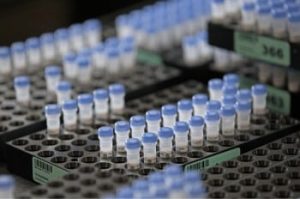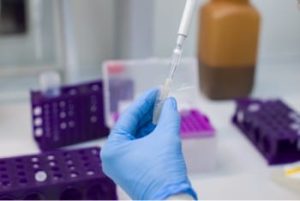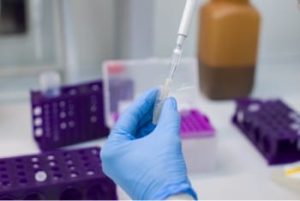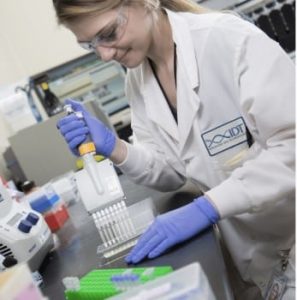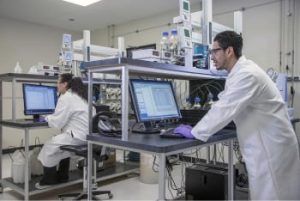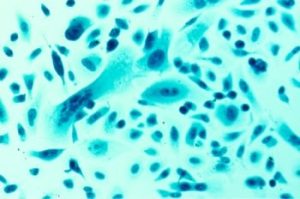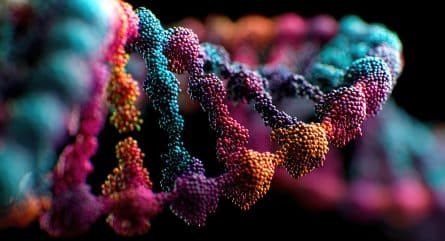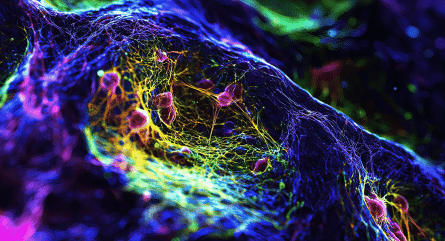Vakulskas CA, Dever DP, Rettig GR, et al. A novel high-fidelity Cas9 delivered as a ribonucleoprotein complex enables high frequency gene editing in human haematopoietic stem and progenitor cells. Nat Med. 2018;24:1216–1224. [1].
Ex vivo RNP-mediated Cas9 genome editing of human hematopoietic stem and progenitor cells (HSPCs) will likely be one of the first Cas9 editing programs to enter clinical phases. Recent studies have shown that disease-causing mutations can be corrected using CRISPR-Cas9 in long-term engrafting HSPCs that are preserved in downstream lineages [2–5]. However, an on-going concern for many researchers is off-target activity introduced by the CRISPR/Cas9 system, which could lead to loss of some critical stem cell functions, or worse, the creation of cancer-causing mutations [6].
Isolation of highly specific Cas9 variant with decreased off-target activity
Methods to reduce off-target activity of CRISPR-Cas9 editing have recently been an area of active research [7–9]. In the Vakulskas et al. paper summarized here, the authors describe the isolation of a Cas9 variant, R691A, that displays a superior on- to off-target ratio when delivered in ribonucleoprotein (RNP) format. Using this Cas9 variant, the authors achieved accurate gene targeting at relevant loci in HSPC and effector cells, while reducing overall off-target editing (OTE). This high-fidelity Cas9 enzyme is now commercially available as IDT Alt-R HiFi Cas9 Nuclease V3.
Click here to learn more about the Alt-R HiFi Cas9 Nuclease V3.
“We performed an unbiased evaluation of several versions of high fidelity Cas9 enzymes in primary human stem cells. We have been very impressed with the characteristics of this new IDT enzyme. Unlike other versions, this version consistently gives us high on-target editing activity, while having low off-target activity. Because of the retained, excellent on-target activity and improved specificity profile, we are excited to use this version in our future experiments focused on developing novel genome editing-based therapies for several diseases with unmet medical needs.”
— Matthew Porteus, MD, PhD, Stanford University, Palo Alto, CA, USA
Use of unique screening approach
A variety of methods have been developed to enable genome editing in mammalian cells. Among these, RNP delivery is often favored, as it leads to a “fast on, fast off” reaction that improves targeting accuracy [3, 4, 10, 11]. While RNP delivery reduces off-target editing (OTE), OTE is not eliminated. Thus, attempts have been made to reduce off-target activity of Cas9 nuclease by rationally mutating multiple amino-acid residues known to participate in the interaction between the Cas9 RNP and target DNA [7–9]. However, for all of these previously reported variants, the OTE reduction occurs at the expense of on-target achievement when using RNP delivery. Therefore, they all have limited utility for applications that require RNP delivery [1].
IDT scientists used a unique approach to evolve the Cas9 nuclease into a more precise genome editing tool. They performed an unbiased, high-throughput bacterial selection scheme to identify the Cas9 mutant that provides the best possible combination of on-target potency and reduced off-target cleavage; see Figure 2A, in Vakulskas et al. [1]. As described in this paper, E. coli cells carrying a plasmid encoding both a cell toxin and a Cas9 target site were transformed with a second plasmid that expresses a random Cas9 open-reading frame (ORF) mutant library and a gRNA that cleaves the toxin encoding gene. Meanwhile, a known off-target site was added to the Cas9/gRNA dual expression plasmid that also encodes an antibiotic resistance gene. This dual positive-selection screening method allows bacterial colonies to survive only when the Cas9 mutant: 1) cleaves the intended on-target site on the toxin plasmid, and 2) does not cleave the known off-target site present on the selection plasmid that confers antibiotic resistance.
After several rounds of screening and testing with different guide sequences, R691A emerged with a promising combination of on-/off-target achievement regardless of delivery by plasmid or as an RNP. All other mutant combinations either exhibited significantly compromised on-target activities, or failed to sufficiently reduce off-target cleavage.
Alt-R HiFi Cas9 Nuclease reduces OTE as measured by NGS
A two-step, NGS-based quantitative process was developed to characterize the off-target editing profile of HiFi versus WT Cas9. Due to a lack of an in silico algorithm that can predict the identity and frequency of off-target events with sufficient accuracy, IDT scientists thus used the GUIDE-seq procedure to empirically identify real off-target sites in cells [6]. They then used an amplicon-based NGS approach to quantify off-target cleavage on sites identified by GUIDE-seq as well as the top computationally predicted off-target sites.
As shown in the top row of Figure 4 in Vakulskas et al. [1], the indel frequency at the intended cleavage site is close to 100% in cells constitutively expressing Cas9. However, on-target editing represents only 28% of total cleavage events in the DNA of those cells, with 72% representing off-target cutting. As expected, WT Cas9 delivered as an RNP reduces or eliminates cleavage at many of the off-target sites. RNP delivery with IDT HiFi Cas9 further improves on- /off-target activity such that on-target events make up >99% of total editing events.
While previous Cas9 variants with reduced off-target cleavage all suffer reduced on-target cleavage when delivered in an RNP format, Alt-R HiFi Cas9 (R691A) achieves high on-target activity and low off-target activity in hard-to-edit primary cells. The Alt-R HiFi Cas9 Nuclease will have broad utility in CRISPR-Cas9 genome editing across a range of applications.
Learn more about how Alt-R HiFi Cas9 potentiates the translation of CRISPR technology into clinical advancements. Click here to review the Nature Medicine article.
References
- Vakulskas CA, Dever DP, Rettig GR, et al. A novel high-fidelity Cas9 delivered as a ribonucleoprotein complex enables high frequency gene editing in human haematopoietic stem and progenitor cells. Nat Med. 2018;24:1216–1224.
- De Ravin SS, Li L, Wu X, et al. CRISPR-Cas9 gene repair of hematopoietic stem cells from patients with X-linked chronic granulomatous disease. Sci Transl Med. 2017;9(372).
- Dever DP, Bak RO, Reinisch A, et al. CRISPR/Cas9 β-globin gene targeting in human haematopoietic stem cells. Nature. 2016;539(7629):384–389.
- DeWitt MA, Magis W, Bray NL, et al. Selection-free genome editing of the sickle mutation in human adult hematopoietic stem/progenitor cells. Sci Transl Med. 2016;8(360):360ra134.
- Traxler EA, Yao Y, Wang YD, et al. A genome-editing strategy to treat β-hemoglobinopathies that recapitulates a mutation associated with a benign genetic condition. Nat Med. 2016;22(9):987–990.
- Tsai SQ, Zheng Z, Nguyen NT, et al. GUIDE-seq enables genome-wide profiling of off-target cleavage by CRISPR-Cas nucleases. Nat Biotechnol. 2015;33(2):187–197.
- Kleinstiver BP, Pattanayak V, Prew MS, et al. High-fidelity CRISPR-Cas9 nucleases with no detectable genome-wide off-target effects. Nature. 2016;529(7587):490–495.
- Slaymaker IM, Gao L, Zetsche B, et al. Rationally engineered Cas9 nucleases with improved specificity. Science. 2016;351(6268):84–88.
- Chen JS, Dagdas YS, Kleinstiver BP, et al. Enhanced proofreading governs CRISPR-Cas9 targeting accuracy. Nature. 2017;550(7676):407–410.
- Hultquist JF, Schumann K, Woo JM, et al. A Cas9 ribonucleoprotein platform for functional genetic studies of HIV-host interactions in primary human T cells. Cell Rep. 2016;17(5):1438–1452.
- Kim S, Kim D, Cho SW, et al. Highly efficient RNA-guided genome editing in human cells via delivery of purified Cas9 ribonucleoproteins. Genome Res. 2014;24(6):1012–1019.
For research use only. Not for use in diagnostic procedures. Unless otherwise agreed to in writing, IDT does not intend these products to be used in clinical applications and does not warrant their fitness or suitability for any clinical diagnostic use. Purchaser is solely responsible for all decisions regarding the use of these products and any associated regulatory or legal obligations. RUO22-1412_001

